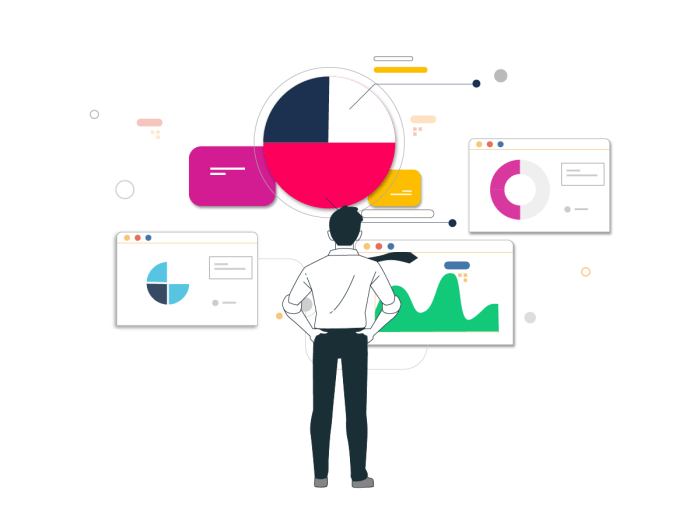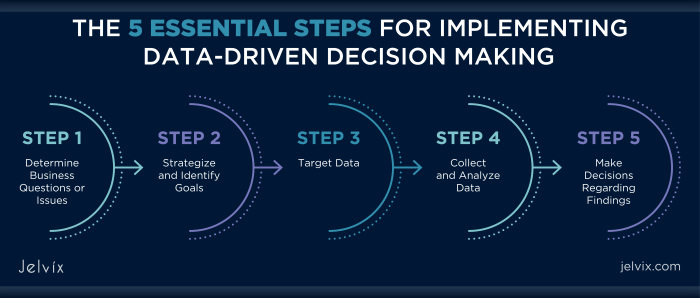Kicking off with Data-Driven Decision Making, this topic is all about using data to make smart choices. From boosting business success to navigating challenges, it’s all here.
Introduction to Data-Driven Decision Making
Data-driven decision making is the process of making choices based on data analysis and interpretation rather than intuition or personal experience. By utilizing data, businesses can identify trends, patterns, and insights that help them make informed decisions to drive success.
In various industries, data-driven decision making has become increasingly crucial. For instance, in the retail sector, companies can analyze customer purchasing behavior to optimize inventory levels and personalize marketing campaigns. In healthcare, data-driven decisions can improve patient outcomes by identifying effective treatments based on historical data.
Examples of Successful Companies Utilizing Data-Driven Decision Making
- Amazon: Amazon uses customer data to recommend products, optimize pricing, and predict future demand, leading to increased sales and customer satisfaction.
- Netflix: Netflix leverages user data to personalize content recommendations, resulting in higher viewer engagement and retention.
- Google: Google utilizes data analytics to enhance search algorithms, ad targeting, and user experience, maintaining its position as a top search engine.
Benefits of Data-Driven Decision Making

Data-driven decision making offers numerous advantages for organizations looking to enhance their operations, strategies, and outcomes. By leveraging data and analytics, businesses can gain valuable insights that lead to more informed and effective decision-making processes.
Improved Accuracy and Precision
Data-driven decision making allows organizations to make decisions based on concrete data and facts rather than relying on intuition or guesswork. This leads to more accurate and precise decision-making, reducing the risk of errors and increasing the likelihood of success.
Enhanced Efficiency and Productivity
By analyzing data, organizations can identify inefficiencies in their processes and operations, allowing them to streamline and optimize their workflows. This leads to increased efficiency, productivity, and overall performance.
Better Customer Insights
Data-driven decision making enables organizations to gain a deeper understanding of their customers’ preferences, behaviors, and needs. By analyzing customer data, businesses can tailor their products and services to better meet customer demands, leading to improved customer satisfaction and loyalty.
Competitive Advantage, Data-Driven Decision Making
Utilizing data to drive decision making gives organizations a competitive edge in the market. By making strategic decisions based on data analysis, businesses can stay ahead of competitors, identify new opportunities, and adapt to changing market trends more effectively.
Real-World Scenarios
One real-world example of the benefits of data-driven decision making is Netflix’s recommendation system. By analyzing user data and viewing patterns, Netflix is able to recommend personalized content to users, leading to increased user engagement and satisfaction.
Another example is Amazon’s use of data analytics to optimize its supply chain management. By analyzing data on customer demand and inventory levels, Amazon is able to predict demand more accurately, reduce excess inventory, and improve delivery times.
In comparison, organizations that rely solely on intuition or gut feelings to make decisions may struggle to stay competitive and may miss out on valuable opportunities for growth and improvement. Data-driven decision making provides a more systematic and reliable approach to decision making, resulting in better outcomes and long-term success.
Implementing Data-Driven Decision Making

Implementing a data-driven decision-making strategy involves a series of steps to ensure successful integration within an organization. By following these steps, businesses can harness the power of data to make informed decisions and drive growth.
Steps in Implementing Data-Driven Decision Making
- Evaluate Current Data Infrastructure: Assess the existing data systems and tools in place to determine if they are capable of supporting a data-driven approach.
- Define Clear Objectives: Establish specific goals and objectives for implementing data-driven decision making to ensure alignment with the organization’s overall strategy.
- Identify Key Data Sources: Determine the relevant data sources that will provide valuable insights for decision-making processes.
- Implement Data Collection Processes: Set up data collection mechanisms to gather, store, and analyze data effectively.
- Utilize Data Analysis Tools: Employ data analytics tools and technologies to interpret and visualize data for decision-making purposes.
- Train Employees: Provide training and support to employees to enhance their data literacy skills and ensure they can effectively leverage data in decision-making.
- Monitor and Adjust: Continuously monitor the implementation of data-driven decision making, gather feedback, and make adjustments as needed to improve the process.
Challenges in Transitioning to Data-Driven Decision Making
- Cultural Resistance: Resistance from employees who are accustomed to traditional decision-making methods and may be reluctant to embrace data-driven approaches.
- Data Quality Issues: Ensuring data accuracy, completeness, and relevance can be a challenge when transitioning to a data-driven strategy.
- Integration Complexity: Integrating different data sources and systems across the organization can be complex and time-consuming.
Tips for Overcoming Resistance to Data-Driven Decision Making
- Communicate the Benefits: Educate employees on the benefits of data-driven decision making, such as improved efficiency, accuracy, and competitiveness.
- Provide Training and Support: Offer training programs and resources to help employees develop the necessary skills to work with data effectively.
- Lead by Example: Encourage leadership to embrace data-driven practices and demonstrate the value of data in decision-making processes.
- Address Concerns: Listen to employees’ concerns and address them openly to build trust and create a supportive environment for implementing data-driven strategies.
Tools and Technologies for Data-Driven Decision Making
Data-driven decision making relies on a variety of tools and technologies to collect, analyze, and visualize data effectively. These tools play a crucial role in helping organizations make informed decisions based on data insights.
Artificial Intelligence and Machine Learning
Artificial intelligence (AI) and machine learning (ML) are at the forefront of data-driven decision making. These technologies enable organizations to analyze large volumes of data quickly and accurately, identify patterns, and predict outcomes. AI and ML algorithms can uncover hidden insights in data that humans may overlook, leading to more informed decision-making processes.
Data Visualization Tools
Data visualization tools are essential for transforming complex data sets into visual representations that are easy to understand. These tools help decision-makers interpret data, identify trends, and communicate insights effectively. Examples of popular data visualization tools include Tableau, Power BI, and Google Data Studio. These tools allow users to create interactive charts, graphs, and dashboards to gain actionable insights from their data.





